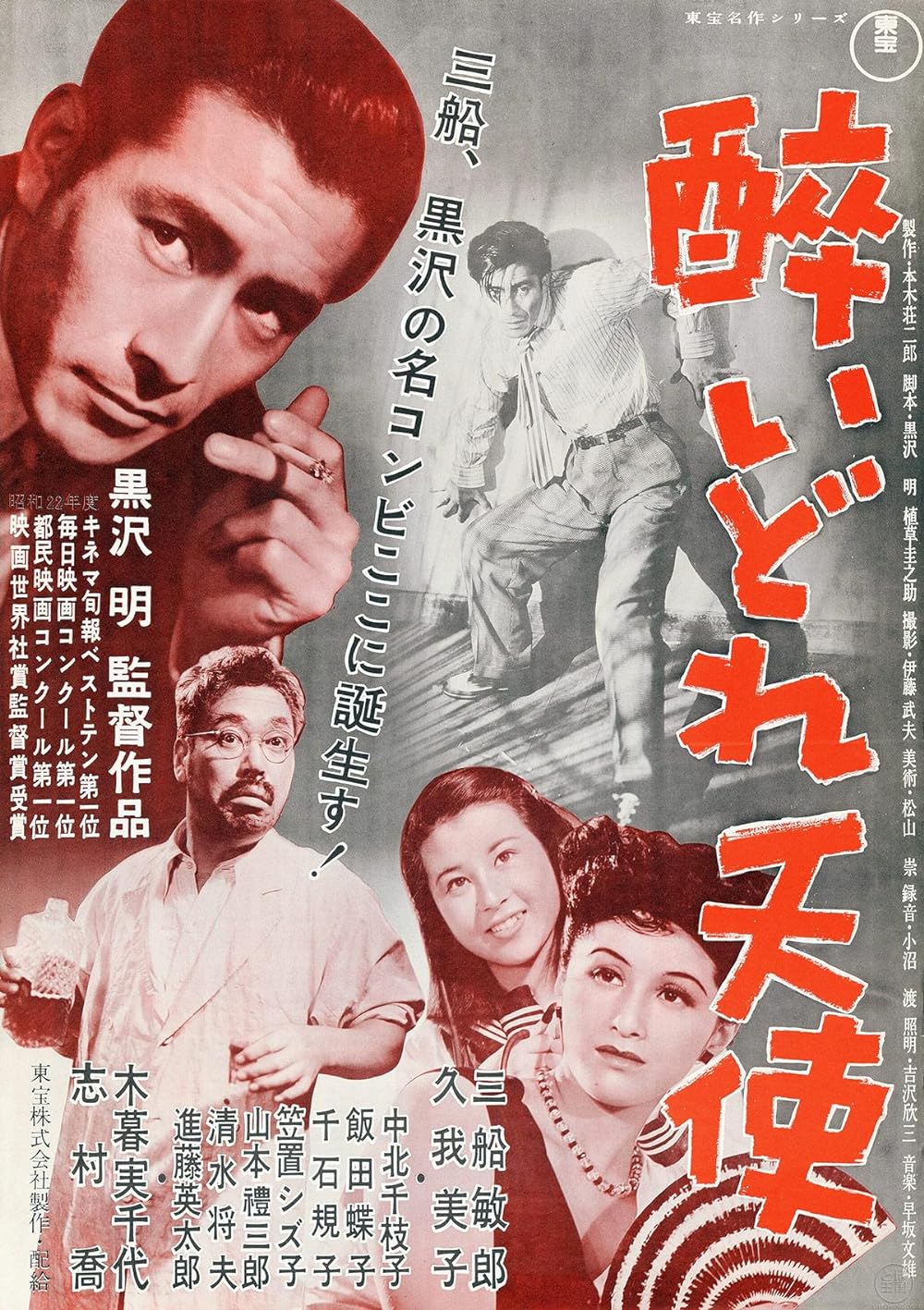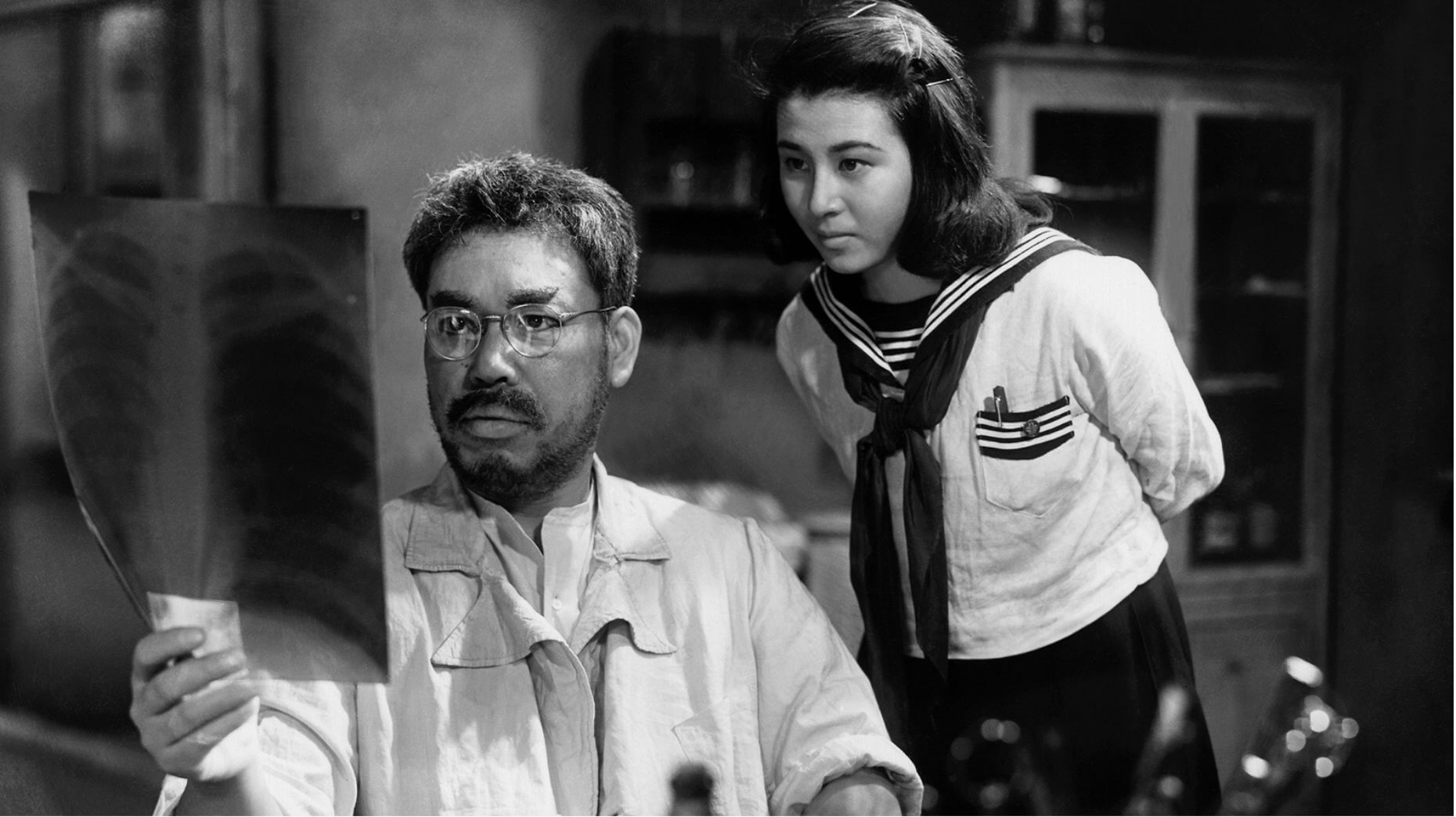Something Like a Filmography takes a (brief) look at the filmography of Akira Kurosawa. Twice a month, Chris and Jon share their impressions of each film, both on its own terms and in terms of Kurosawa’s legacy and its intersection in the Cinema Dual hosts’ lives.
FROM THE BOX: In this powerful early noir from the great Akira Kurosawa, Toshiro Mifune bursts onto the screen as a volatile, tubercular criminal who strikes up an unlikely relationship with Takashi Shimura’s jaded physician. Set in and around the muddy swamps and back alleys of postwar Tokyo, Drunken Angel is an evocative, moody snapshot of a treacherous time and place, featuring one of the director’s most memorably violent climaxes.

WHAT CHRIS THOUGHT: I’m not sure you could have asked for a better entrance for Mifune in Kurosawa’s oeuvre. Another great example of commenting on post-war Japan without specifically making it the center of the story, Drunken Angel is almost athletic in its exuberance, from Shimura’s extroverted performance as the titular character, an alcoholic doctor treating patients in the polluted ghettos of Tokyo to Mifune’s beastial entrance as the gangster fighting between his nature and his environment as a gang boss suffering from tuberculosis. When the two are paired together it’s absolute magic, something Kurosawa obviously gleaned immediately since so much of what we’ll cover for the rest of this year has the two actors featuring in almost all his films. The film looks marvelous, a tribute to Criterion’s restoration as well as Kurosawa’s willingness to make the camera an active part of the story. The climax, in which near overcome by his disease Mifune’s Matsunaga has a final, violent showdown with returning mob boss Okada (a suave and menacing Reisaburo Yamamoto) is a striking example of how muscular a filmmaker Kurosawa can be, using white paint in startling fashion to highlight the life and death struggle between the two adversaries.

WHAT JON THOUGHT: In this series, the arrival of Toshiro Mifune is one that is long awaited. In Drunken Angel, the first of their movies together, Mifune’s Matsunaga is an electric supporting player to Takashi Shimura’s gruff doctor Sanada. The first half of the movie mostly focuses on Sanada’s heroic efforts to chase after and brow beat Matsunaga into letting Sanada treat him for tuberculosis. Shimura shines in his first leading role of this series as the rough around the edges doctor with a heart of gold (Mifune will embody a similar role himself at the end of his Kurosawa run). The second half of the movie belongs to Mifune, as he navigates the life or death stakes ahead of him, armed with the knowledge of how his loyalty to the yakuza is both unrequited and fatal. We see his vulnerability when he acknowledges his condition, and his prowess when he doesn’t. That he ultimately still can’t choose to leave the yakuza behind is the film’s tragedy, made worse by Sanada pronouncing that he cannot forgive Matsunaga for wasting his life.

ANYTHING ELSE, CHRIS? I can’t remember if I got this from the supplemental material on the DVD or from Richie’s The Films of Akira Kurosawa, but I love the sneaky influence of western culture throughout the film as a sort of corrupting influence, from the attire of the gangsters as Jon mentions below to the use of the mysterious guitar player seen in the background of the polluted neighborhood. There are also lovely nods to German expressionism and surrealism, as in the dream sequences of Matsunaga’s death near the ocean and the incredible makeup job that gradually transforms Matsunaga from virile man’s man to a weakened, walking corpse. The bubbling gunk serves as a reminder of the simmering tensions throughout the film, and lastly I want to call out how refreshing it is to see Shimura let loose like he does here. Usually relegated to more reserved roles (I may go on for pages when we get to him in Seven Samurai), its wild to see him drink, fight, and throw things in his frustration as Mifune’s utter cowardice to take take care of himself.
ANYTHING ELSE, JON? While Kurosawa had talked about the Japanese censors most unkindly in the movies he made during the war, he also had to contend with post-war American censors as well. On a script level, he couldn’t avoid some of the changes required by the censors, however, his use of visual language allowed some of his more subtle criticisms to get past. The gangsters dressed like Americans, the prominently featured poisonous bog stood in for the damage done by the war. But the film’s visual highlight is Matsunaga’s dream of opening his own coffin. Kurosawa uses unusual locations and clever editing tricks to show us Matsunaga’s surreal reflections on the lure of an attractive yet fatal lifestyle. But even here, the scene depends on Mifune being willing to get weird with Kurosawa, something he jumps into without hesitation. On an unrelated note, since I don’t know yet how much she figures into her next and final movie with Kurosawa, I wanted to shout out Chieko Nakakita one last time who still brightens up the screen as nurse Miyo in her brief moments on screen.

THE FINAL WORD(S): For Chris and Jon, this feels like where the threads really come together and resolve into the filmmaker we know Kurosawa to be, the true start of his classic period.
NEXT TIME: From patient to doctor, we return to Mifune and Shimura grappling with disease and conscience in The Quiet Duel.


Leave a comment